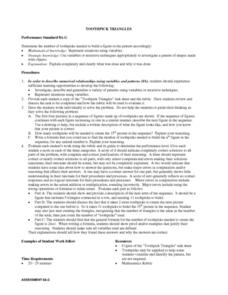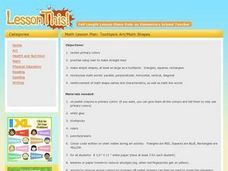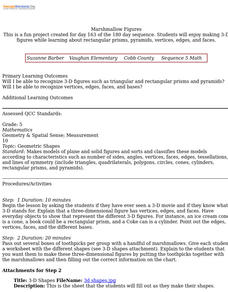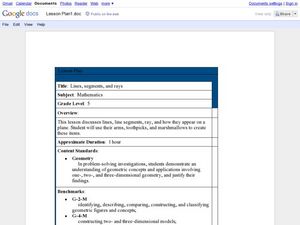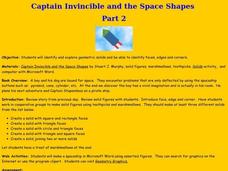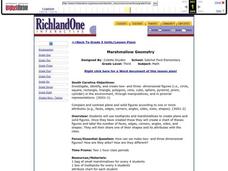Curated OER
Toothpick Triangles
Students draw a chart (included in the lesson) to use with their investigation. They review terminology of triangles and receive toothpicks to use in the lesson. Beginning with three toothpicks, students form a triangle. They complete...
Curated OER
What are the Kinds of Triangles?
Fifth graders classify triangles. In this triangle lesson, 5th graders learn about the characteristics that make up a triangle. They are instructed through video, PowerPoint slides, and teacher-led demonstrations.
Curated OER
Toothpick Triangles
Explore patterns, variables, and mathematical relationships when you examine patterns with toothpicks and determine the next sequence of figures. Your class writes and justifies a formula based on the sequence. An answer key is included.
Curated OER
Measuring the Egyptian Way using the Pythagorean Theorem
Students measure using the Pythagorean Theorem. In this geometry instructional activity, students solve right triangles using the properties of the Pythagorean theorem. They apply the same knowledge to solving story problems.
Curated OER
Toothpick Art
Learners review primary colors and practice making straight lines. In this visual arts instructional activity, students paint simple shapes as large as a toothpick, using specific primary colors. During the construction of the shapes...
Curated OER
Toothpick Bridge Design
Eighth graders are introduced to what makes a strong, sound structure. They explore about the truss structure, the importance of the strength of the triangle and the distribution of forces along the truss. Students work in teams to...
Curated OER
Silica Tetrahedron Model
Very simply, pairs of learners construct a model of the tetrahedral silica structure using raisins and toothpicks. They dip it into a soapy solution and then blow a bubble "atom" into its center. The lesson plan gives instructions that...
Utah Education Network (UEN)
Geo Shapes
Invite your first graders to compose and decompose two and three-dimensional figures with this fun, hands-on lesson. They investigate and predict the results of putting together and taking apart two-dimensional shapes with rubber bands...
Curated OER
Marshmallow Figures
Students enjoy making 3-D figures while learning about rectangular prisms, pyramids, vertices, edges, and faces. After a lecture/demo, students use marshmallows, toothpicks and a worksheet imbedded in this lesson to create 3 dimensional...
California Academy of Science
Fish Forms
I've said it before, and I'll say it again, you can add art to any lesson! While little learners are discovering why fish have specific body parts such as, scales, fins, and gills, they start making three-dimensional fish forms. Children...
Curated OER
Lines, Segments, and Rays
Fifth graders use their arm, toothpicks, and marshmallows to create lines, segments, and rays. In this lines, segments, and rays lesson plan, 5th graders learn how these appear on a plane.
Curated OER
Concepts, Patterns, Formulas, Substitution
In this algebra lesson plan, students define algebraic terms and rewrite them using math symbols. There are 10 problems drawing correlations to geometry as well as algebra.
Curated OER
Captain Invincible and the Space Shapes
Students recognize the features of geometric shapes. In this geometric shapes activity, students listen to Captain Invincible and the Space Shapes. Students create solid figures with marshmallows and toothpicks. Students...
Curated OER
Straw Shapes
Students view a video on bridges and domes. They discuss the importance of shapes, especially triangles for these structures. They participate in an activity in which they create their own dome out of paper clips.
Curated OER
Different Minerals
In this minerals worksheet, students read about the relationship between elements, rocks and minerals. They experiment using 6 different colored gumdrops to represent 6 common elements. Students construct gumdrop and toothpick models of...
Curated OER
Exploration with Geometric Solids
Students reinforce geometric concepts by playing "Guess My Solid." Through a process of elimination, they determine the shapes of mystery solids. Finally, students use various materials to construct their own geometric figures.
Curated OER
Words to Numbers
Seventh graders translate word problems into numerical expressions. Through guided practice, 7th graders discover how to take the information contained in a word problem and create a numerical expression using variables. They...
Curated OER
Marshmallow Towers
Students explore geometry by completing a marshmallow activity in class. In this architecture lesson, students identify the jobs of civil engineers and architects while identifying different geometric shapes as well. Students utilize...
Curated OER
Linear Sculpture
Learners discuss how artists communicate visually in their work using the elements of design. The elements of design should be used as the building blocks of the structure you are trying to create. The elements of design are form, space,...
Curated OER
Logic
Pupils solve problems using reasoning techniques, identify the validity or non-validity of problems and use deductive reasoning for problem resolution.
Curated OER
Marshmallow Geometry
Third graders create 2D and 3D shapes using marshmallows and toothpicks. In this geometry instructional activity, 3rd graders create their shapes and document the number of faces, edges, corners, angles, and sides. They share one shape...
Curated OER
Geodesic Dome
Young scholars build geodesic domes using newspaper after watching a video about the architectural concepts used in building domes. They decide which geometric shapes can be used to build the strongest building.
Curated OER
Symmetry in Shapes and Everyday Objects
Fifth graders discover lines of symmetry for shapes and everyday objects. In this lines of symmetry activity, 5th graders use a butterfly outline to find lines of symmetry. Students analyze everyday objects for symmetry and use...
Curated OER
Woody Sine
Students explore the concept of sine. In this sine lesson, students create a sine graph from tooth picks. Students create a unit circle with tooth pick length radius. Students then take the tooth picks from the unit circle and put them...
